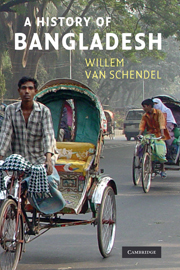Book contents
- Frontmatter
- Contents
- List of plates
- List of maps and figures
- Acknowledgements
- Timeline
- Introduction
- PART I THE LONG VIEW
- PART II COLONIAL ENCOUNTERS
- PART III BECOMING EAST PAKISTAN
- 11 The Pakistan experiment
- 12 Pakistan falls apart
- 13 East Pakistani livelihoods
- 14 The roots of aid dependence
- 15 A new elite and cultural renewal
- PART IV WAR AND THE BIRTH OF BANGLADESH
- PART V INDEPENDENT BANGLADESH
- Conclusion
- Bangladesh district maps
- Key political figures since 1947
- Glossary of Bengali terms
- Notes
- Bibliography
- Index
13 - East Pakistani livelihoods
Published online by Cambridge University Press: 05 February 2015
- Frontmatter
- Contents
- List of plates
- List of maps and figures
- Acknowledgements
- Timeline
- Introduction
- PART I THE LONG VIEW
- PART II COLONIAL ENCOUNTERS
- PART III BECOMING EAST PAKISTAN
- 11 The Pakistan experiment
- 12 Pakistan falls apart
- 13 East Pakistani livelihoods
- 14 The roots of aid dependence
- 15 A new elite and cultural renewal
- PART IV WAR AND THE BIRTH OF BANGLADESH
- PART V INDEPENDENT BANGLADESH
- Conclusion
- Bangladesh district maps
- Key political figures since 1947
- Glossary of Bengali terms
- Notes
- Bibliography
- Index
Summary
The political collapse of Pakistan had deep roots in economic frustration. In the 1940s, most supporters of Pakistan had been full of hope for the Bengal delta's rapid improvement. They thought that independence was bound to make the region flourish because it would rid itself of the exploitative colonial system and remove the landlords, merchants and officials who had personified it. Of course, Partition would create initial dislocations that needed to be overcome but the longer-term prospects were thought to be bright.
After Partition, however, things suddenly looked much more complicated. The Muslim League leadership was ill-prepared to govern, its policies were not geared towards invigorating the Bengal delta economy and its attempts to construct a national economy turned out to have numerous unanticipated effects. Moreover, population exchange was far more extensive and disruptive than had been expected. The early years of East Pakistan, as the Bengal delta was now known, were characterised not only by political volatility but also by economic turmoil.
POPULATION EXCHANGE
The Partition of 1947 was a demographic disruption of the first order. Huge numbers of people were on the move. In the Punjab, in the west, population exchange was a massive and swift fratricidal horror. In Bengal it was slower, not quite so violent, but equally massive. Here migration prefiguring Partition had begun in 1946, after riots in Kolkata, Noakhali and Bihar. In August 1947, at the time of Partition, a number of distinct groups began to migrate.
- Type
- Chapter
- Information
- A History of Bangladesh , pp. 131 - 143Publisher: Cambridge University PressPrint publication year: 2009



